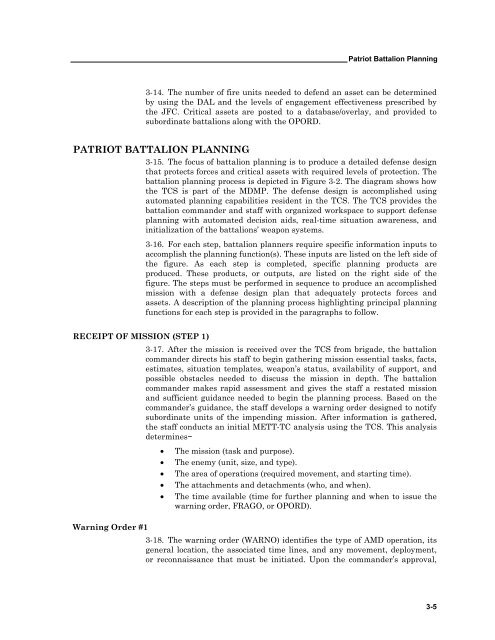FM 3-01.85: Patriot Battalion and Battery Operations - BITS
FM 3-01.85: Patriot Battalion and Battery Operations - BITS
FM 3-01.85: Patriot Battalion and Battery Operations - BITS
Create successful ePaper yourself
Turn your PDF publications into a flip-book with our unique Google optimized e-Paper software.
<strong>Patriot</strong> <strong>Battalion</strong> Planning<br />
3-14. The number of fire units needed to defend an asset can be determined<br />
by using the DAL <strong>and</strong> the levels of engagement effectiveness prescribed by<br />
the JFC. Critical assets are posted to a database/overlay, <strong>and</strong> provided to<br />
subordinate battalions along with the OPORD.<br />
PATRIOT BATTALION PLANNING<br />
3-15. The focus of battalion planning is to produce a detailed defense design<br />
that protects forces <strong>and</strong> critical assets with required levels of protection. The<br />
battalion planning process is depicted in Figure 3-2. The diagram shows how<br />
the TCS is part of the MDMP. The defense design is accomplished using<br />
automated planning capabilities resident in the TCS. The TCS provides the<br />
battalion comm<strong>and</strong>er <strong>and</strong> staff with organized workspace to support defense<br />
planning with automated decision aids, real-time situation awareness, <strong>and</strong><br />
initialization of the battalions’ weapon systems.<br />
3-16. For each step, battalion planners require specific information inputs to<br />
accomplish the planning function(s). These inputs are listed on the left side of<br />
the figure. As each step is completed, specific planning products are<br />
produced. These products, or outputs, are listed on the right side of the<br />
figure. The steps must be performed in sequence to produce an accomplished<br />
mission with a defense design plan that adequately protects forces <strong>and</strong><br />
assets. A description of the planning process highlighting principal planning<br />
functions for each step is provided in the paragraphs to follow.<br />
RECEIPT OF MISSION (STEP 1)<br />
3-17. After the mission is received over the TCS from brigade, the battalion<br />
comm<strong>and</strong>er directs his staff to begin gathering mission essential tasks, facts,<br />
estimates, situation templates, weapon’s status, availability of support, <strong>and</strong><br />
possible obstacles needed to discuss the mission in depth. The battalion<br />
comm<strong>and</strong>er makes rapid assessment <strong>and</strong> gives the staff a restated mission<br />
<strong>and</strong> sufficient guidance needed to begin the planning process. Based on the<br />
comm<strong>and</strong>er’s guidance, the staff develops a warning order designed to notify<br />
subordinate units of the impending mission. After information is gathered,<br />
the staff conducts an initial METT-TC analysis using the TCS. This analysis<br />
determines−<br />
The mission (task <strong>and</strong> purpose).<br />
The enemy (unit, size, <strong>and</strong> type).<br />
The area of operations (required movement, <strong>and</strong> starting time).<br />
The attachments <strong>and</strong> detachments (who, <strong>and</strong> when).<br />
The time available (time for further planning <strong>and</strong> when to issue the<br />
warning order, FRAGO, or OPORD).<br />
Warning Order #1<br />
3-18. The warning order (WARNO) identifies the type of AMD operation, its<br />
general location, the associated time lines, <strong>and</strong> any movement, deployment,<br />
or reconnaissance that must be initiated. Upon the comm<strong>and</strong>er’s approval,<br />
3-5
















